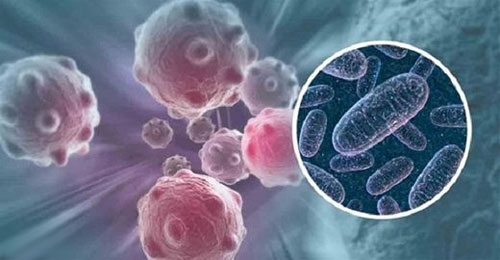The metabolic approach to cancer treatment (2)
By Dr. Joseph Mercola
Read the first part of the article

High glucose and insulin resistance worsen your prognosis
As noted by Winters, when you look at the statistics across all tumor types, all stages and demographics, chemotherapy has about a 3% success rate across the board. Radiation has about a 12% success rate and surgery, about a 50% success rate, with “success rate” referring to debulking or making the tumor smaller – not eliminating evidence of the disease.
She also points out evidence showing that when your glucose and insulin are elevated, radiation becomes ineffective, as cancer cells are desensitized to radiation when they’re being bathed in sugar.
“I think about all the patients who are metabolically unstable, metabolically inflexible, prediabetic. [Treatment at this time] basically means you just created a lot more damaged environment, a lot more possibility for mutating cells and a lot more possibility for recurrence and progression, simply because someone didn’t take the time to just do a simple finger stick or blood draw just to see what your glucose levels were,” she says.
Another factor that makes radiation ineffective is elevated vasoendothelial growth factor. Again, a simple blood test can help you assess how likely it is that treatment with radiation will be successful. Winters recommends patients undergoing radiation to spend a few weeks or months preparing their body for radiation, focusing on lowering insulin growth factor (IGF), hemoglobin A1C and glucose.
She may also add in certain radio sensitizing agents, such as melatonin or astragalus, to improve therapy response. Radiation combined with hyperthermia done on the same day has also been shown to dramatically improve results. With regard to chemotherapy, Winters is a strong advocate against the conventional maximum tolerated dose approach.
“When you do it at that level, you not only create a cytotoxic direct cell kill, but you actually simultaneously enhance an immune response. The way we do chemo today obliterates the immune system. And the only way you can really overcome cancer and stay in … remission … is with a functioning immune system.”
Instead, she recommends using chemo at metronomic or fractionated levels, giving it at about a tenth of what would normally be given, which can be done with great effect provided the patient is sufficiently prepared through nutritional ketosis and other aids.
“We don’t guess,” Winters says. “We actually put together a very precise, bullseye approach to each and every individual. We continue every three months while they’re in the cancering process.
Until their trifecta is perfect, we continue to assess and we continue to tweak the treatment because those cells, once they’ve been exposed to a new treatment over a short period of time, typically three to six months, they will have morphed and mutated into an entirely new animal. We have to be a few steps ahead of that process each and every time.
We can’t hit every single pathway with chemotherapy, or it will kill the patient outright. But there are things like the ketogenic diet, which impacts all 10 of the hallmarks of cancer simultaneously, thereby enhancing the effect of whatever therapy you overlay on it.
None of these therapies should ever be considered individually, nor is there ever going to be such a thing as a single magic bullet for cancer. That is where we get seduced by the pharmaceutical industry and even the nutraceutical and alternative medical industry, to think there’s one cause and one cure for this process. It is just that. It is a process and it’s just as unique in each of us as our fingerprints.”
Nutritional ketosis in cancer treatment

Like me, Winters views nutritional ketosis (a ketogenic diet) as one of several tools to achieve metabolic flexibility. Others include intermittent fasting, exogenous ketone supplementation, certain pharmaceutical interventions or caloric-restrictive patterns of eating.
“We were all naturally meant to be these hybrid engines,” she says. “When we talk low-carb eating, that was actually normal carb eating until about 1850, when we started to process sugar, flour and salt and started to put it in everything. We were all, in essence, low-carbers. It wasn’t a fad. This was just the way it was.
Ultimately, what happens when we [are] in a metabolically flexible state or have ketones in our system at certain times, especially around our time of chemo, radiation, surgery, targeted therapies and hormone-blocking therapies, we enhance those therapies.
It’s like somehow those ketones are like a Trojan horse that carry that toxic therapy right to its target. It gives some support to the healthier cells around it. I see it as a therapeutic tool. I never see it as a standalone by itself.
That, I think, is an important piece to put out there and to realize there are multiple ways to enhance outcomes. But that’s one of the most significant ways to hit multiple targets at once and really lower a lot of the side effects.”
Addressing cachexia
Now, when a cancer patient experiences cachexia (loss of weight and muscle mass), testing becomes crucial. As noted by Winters, “being skinny will not kill you, but being cachectic can,” and you cannot tell whether someone is cachectic or not simply by looking at them.
“We do that when we start to see the weight come off on a scale and folks go in for their chemotherapy. Doctors freak out. Their team starts to tell them, ‘No matter what, don’t lose more weight. Eat, eat, eat, eat, eat.’ Yet, cachexia is an inflammatory, cytokine-driven process. It’s very much driven by sugar. It’s inflammation and metabolic imbalance.
The worst thing you can ever give a patient with cachexia is Boost, Ensure or total parenteral nutrition (TPN). Actually, on many cancer wards, TPN is basically known as the beginning of the end. When you look at the first ingredients of all of those it’s highly synthetic, highly toxic, four different types of sugars gluten and all types of things that kick up that inflammatory process even more.”
To assess whether a patient is in cachexia, Winters uses a metabolic panel that shows protein, creatinine, calcium and albumin. Specifically, if protein is below 7 and albumin below 4, then the patient is slipping into sarcopenia and metabolic wasting, which is part of the process of cachexia.
Importantly, if you are in cachexia, sudden refeeding with sugar after not having eaten anything for some time can literally kill you. This is known as “refeeding syndrome.” It’s a very dangerous medical condition that can rapidly shut down your organs. Cachexia itself is also very concerning, and actually kills about 40% of cancer patients, according to Winters.
“We see this a lot in cancer wings around the world. My patients, interestingly enough, patients who have come out of cachexia the best were those who we were able to safely fast or safely kick into ketosis, whether it was exogenous ketones, or start to slowly increase their fat intake to what was tolerated, because the nature of cachexia is an absolute loss of hunger,” Winters says.
“Thanks to things today, such as medical marijuana, we can often restart their endocannabinoid system and re-up their ability to have hunger and kick in that part of the brain that has been shut down with a state of cachexia and actually stabilize them and then reverse it. This is a condition that is not reversible by Western standards.
I try to keep patients between 0.8 and 1 grams of protein per kilogram in cancer patients normally. But when cachexia hits, we start to go up by a couple of tens of a point every few days. We might go 1.2 grams, 1.5, 1.8 or 2 max. I don’t go above 2 [grams].”
More information
This extensive and detailed interview contains far more information than I can provide here, so if this is a topic of interest to you, I strongly recommend listening to it in its entirety.
In closing, Winters says:
“You know, a few years ago, I would not have even had an opportunity to sit down with a general family practitioner and have this conversation. And yet, today, every week I’m speaking with conventional oncologists all over the world that are being, frankly, kind of pushed, coerced or forced by their patients to have a consultation with me on their behalf.
At first, they’re a bit resistant, until they realize that I’m simply trying to enhance their outcomes. That I’m not trying to do an either/or. I’m trying to help them understand that the tools in their toolbox can be used differently and can be used a bit more effectively and even more safely.
It’s taken things like some of these tumor cell assays and blood cell assays, like Biocept, Guardant360 or FoundationOne, to help them start to have a common language to understand that there are more targets to address than simple standard of care chemotherapy radiation or surgery.
[It] has really changed the conversation. We’re all more in-dialogue versus an either/or process. I think that it’s becoming a pretty cool, accessible, appreciated strategy among my colleagues.
It’s a lot of fun to see lightbulbs go off and to see them put together all the pieces of their life and education, coming together at once to realize they actually do know this stuff. They just have never quite forayed it or put it together in this way that can really change how their patients are being managed.
No. 2, the limiting factor. For instance, I have a doctor I speak with a lot from University of California San Francisco [who is] very up in the field of this. The problem is, ironically, if he recommended metronomic, which is the lower fractionated dosing of chemotherapy, to his patients, it would not be covered by insurance.
How insane is that? That is considered off-label drug use It is not considered standard of care; therefore, it is not covered by insurance.
Unfortunately, where we are in this moment, which I am on a mission to change, is that you will likely have to track down people out of network, out of pocket, to get the proper treatment, to actually test, assess and address your cancer to your biochemically unique self to have a good outcome. That sucks, but that’s just the way it is right now.”
You can learn more about Winters’ approaches in her 2017 book, “The Metabolic Approach to Cancer: Integrating Deep Nutrition, the Ketogenic Diet and Nontoxic Bio-Individualized Therapies,” which outlines her process in some detail.
If you would like to engage her services, or more specifically, have your clinician consult with her, visit website, drnasha.com. At the bottom of the homepage, you’ll find a patient resource section with free tools. Go ahead and download the free guide describing the five steps to take when diagnosed with cancer. It gives a lot of the information shared in this interview.
Your clinician will need to go to the doctor section to sign up for a consultation. “It breaks down exactly what’s required – those five labs we discussed,” she says. “Any other relevant data, testing, imaging, anything, I would get it all.” As the patient, you would also be asked to create a chronology of significant events of your life that led to your diagnosis.
Should your doctor refuse to consider a consultation to learn about some of the options, Winters may be able to help you find a local physician that is receptive to collaboration. Even if you don’t do anything with your consultations, it certainly would not hurt to do that first. It’s relatively inexpensive, and will give you a firm base of understanding of where you are and what’s going on in your body.
Biopsies will likely become a thing of the past
Thomas Seyfried, Ph.D., a leading expert on cancer as a metabolic disease, is of the strong opinion that biopsies should be avoided, as they may trigger metastasis, i.e., spread, of the cancer. The reason for this is because it isn’t so much cancer stem cells spreading the disease as it is hybridized, morphed macrophages that fuse with cancer cells.

Because it’s a macrophage, it spreads through your blood and could seed into other tissues. Winters notes that concerns over biopsies spreading cancer have been in circulation for decades.
“We’ve seen many times that depending on the timing, let’s say, of your cycle when you have a mastectomy or the type of anesthesia used at a time of a biopsy, or the state of the overall health, or even the size of the core biopsy chamber, that we definitely have that potential to seed,” she says.
Despite such risks, clinicians still had to do the biopsy, no matter what, to help guide the treatment. That is now changing, she says. Blood biopsies are improving, allowing a diagnosis to be made without puncturing tissue. From the research and work summits she’s attended on circulating tumor cells and circulating stem cells, Winters is convinced it won’t be long before biopsies will no longer be used.
Tools for optimizing surgical success
While radiation and chemotherapy are rarely an ideal option, surgery may be indicated in some cases, and your success rate can be optimized by implementing nutritional ketosis. Fasting for a few days before surgery can help define and demarcate the margins of the tumor. Cancer cells will also be less aggressive as they’ll be relatively debilitated.
An important point to be made here is that undergoing conventional treatment – radiation, chemo and/or surgery – first, before adopting a holistic approach, is going to massively set you back and will more or less eliminate any real chance of success. In other words, you need to be brave enough to address the terrain of your body first, before doing any of these invasive and highly toxic interventions. According to Winters:
“If it’s a particular tumor that came on fast in a part of the body that’s blocking something like a vessel, or obstructing the colon or whatnot – those become medical emergencies [requiring immediate treatment].
However, the vast majority of cancer diagnoses are nonemergencies. The real emergency is the diagnosis itself, and the way you react or respond to that emergency will often dictate your success at overcoming or maintaining this process. I’m really thankful for the opportunity to say this on a much larger platform because it’s very important …
I always encourage people, ‘Take a breath. Dive deep into your terrain. Really understand what’s making it tick right now before you choose any intervention. And then you will likely not have to see me again because you won’t likely be in that 70% recurrence rate. [J]ust take a moment and reframe and get clear on what is specifically right for you.
That being said, if I know someone is getting ready to prepare for a surgery or a biopsy – because I treat them the same, whether it’s just a tiny little punched lesion to look at if this is a melanoma, or something that’s opening up the body cavity – we like to spend at least a couple of weeks prepping the body.
We like to start things like modified citrus pectin. We start to get them into a fasted state or a metabolic flexible state for the weeks leading up, and a fasted state going into the surgery itself. If we are lucky enough to have their single nucleotide polymorphisms (SNPs), we can really help them decide on the best strategy for pain management.
We do our best to have them avoid opiates at all cost because it’s really related to slowing down wound healing, increasing cancer cell proliferation and destroying the microbiome, as well as all the issues that it has around addiction and at really not helping the pain in the way it needs to be helped.
We also do post-surgical intervention to help them heal up from that wound as quickly as possible. Maybe a bit more protein is needed at that time, maybe a little bit less sodium.
If they’re a woman who is still menstruating, we will try and schedule their surgery where the estrogen levels in their menstrual cycle are at their lowest. That’s an interesting strategy we’ve used for better outcomes. Testing is a very powerful tool, as are some homeopathic remedies like phosphorus to help with drug reaction and bleeding issues.”
yogaesoteric
October 11, 2019
Also available in:
 Français
Français
